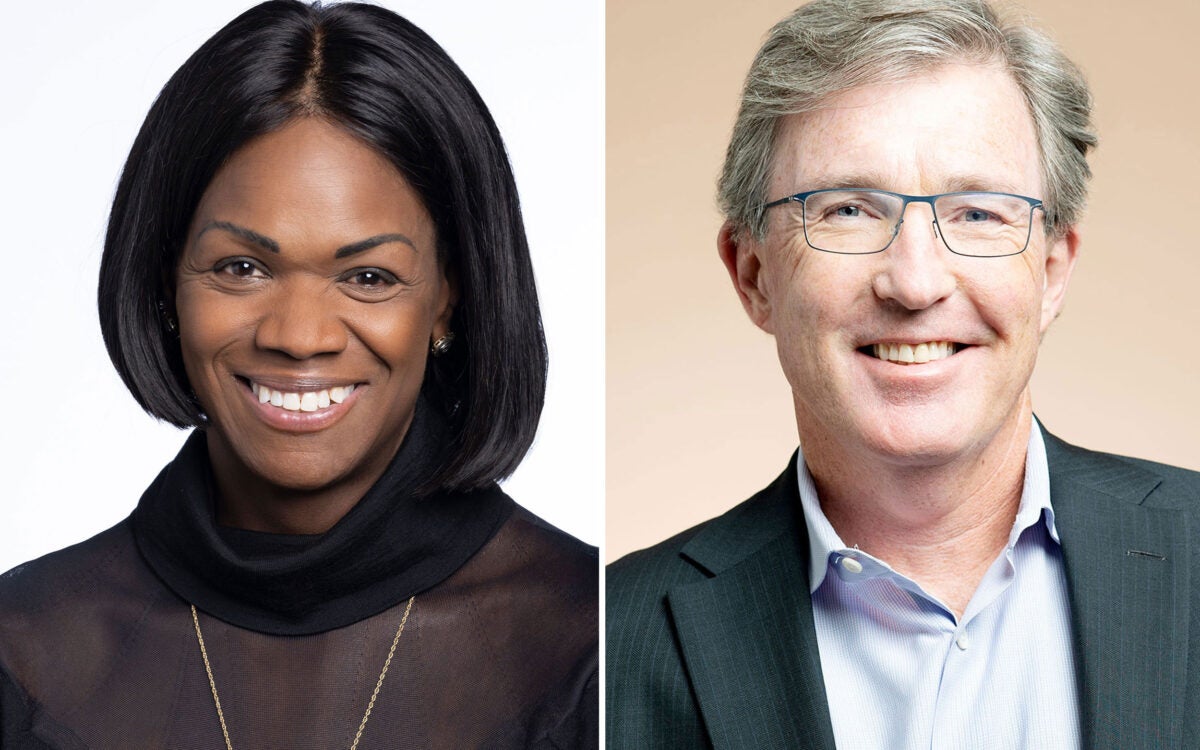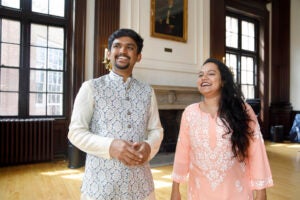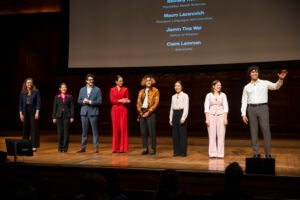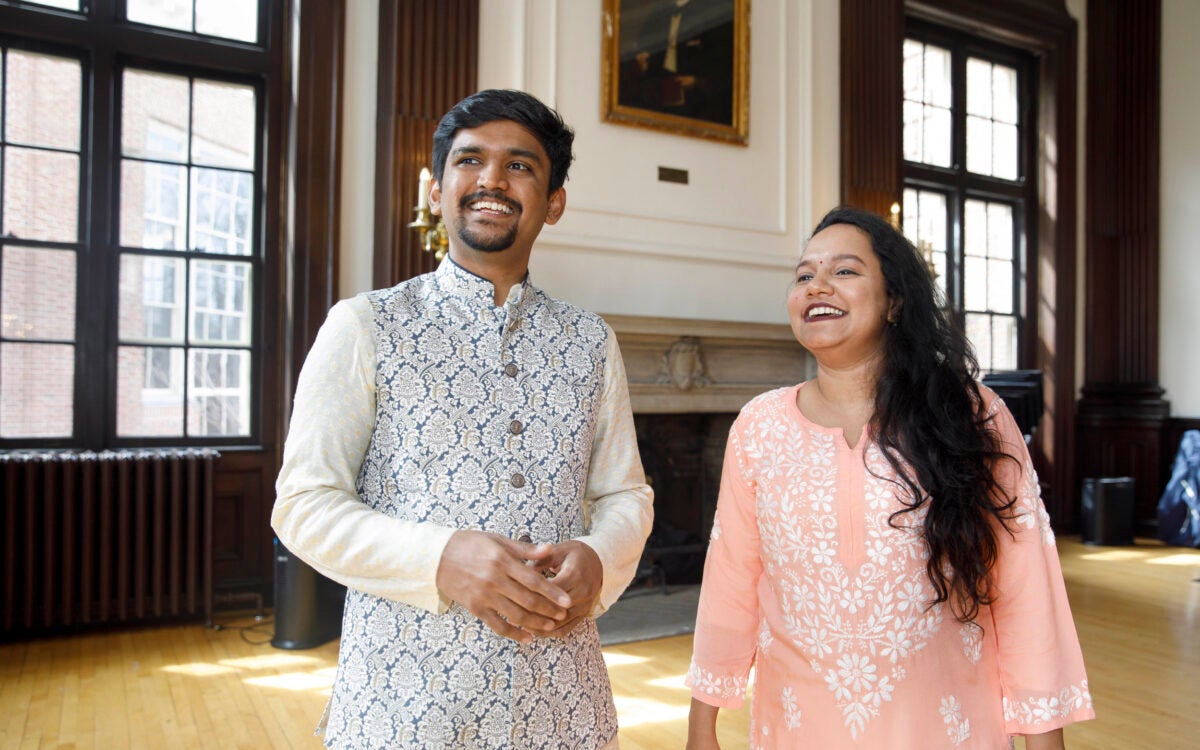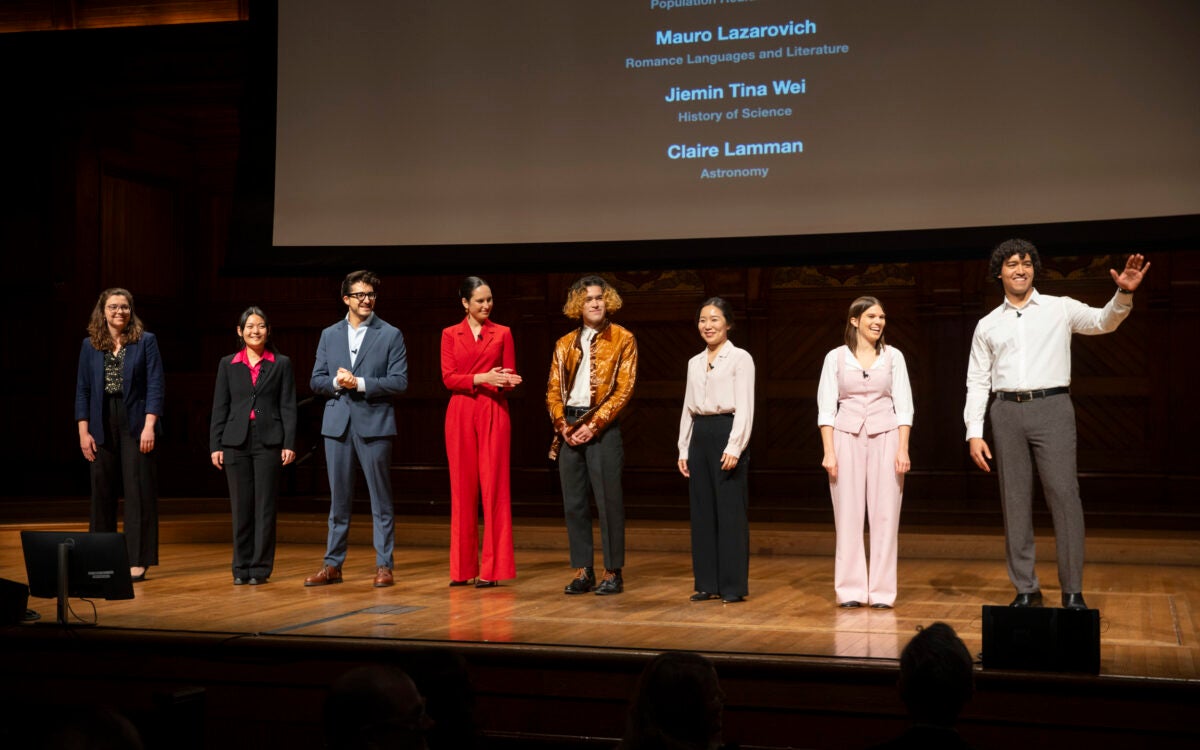
Locally grown kale was on the menu at the “sustainable dinner” at Annenberg Hall. The Earth-friendly menu of local and regional foods supports area producers and minimizes transportation pollution.
Jon Chase/Harvard Staff Photographer
Earth Day at 40
Food, fairs, lectures mark Harvard’s April 22
Harvard celebrated the 40th anniversary of Earth Day this week (April 22) with earnest lectures, probing conferences, sunlit outdoor fairs — and green dinner trays.
Campuswide, dinner featured an Earth-friendly menu of local and regional foods that support area producers and minimize transportation pollution.
Harvard University Hospitality and Dining Services (HUHDS) put it all together. It was one of several “sustainable dinner” nights since October 2008, when the University used a special dinner to celebrate its pledge to reduce greenhouse gas emissions. Since then, there has been a sustainable dinner night each fall and one each spring, on or around Earth Day.
But don’t be fooled, said HUHDS spokeswoman Crista Martin. Mealtime at Harvard is sustainable every day, to the degree it is possible to serve food drawn in from 250 miles away or less.
“Most of the [April 22] menu features items that are available consistently,” she said. “But it’s wonderful to highlight in one big delicious night what’s happening every day.”
Here’s a taste of Harvard’s Earth Day menu: borscht from local beets, Maine lobster bisque, and Vermont herb-roasted chicken. Add in tomatoes Provençal and garlic mashed potatoes (from Maine produce). And there was local four-berry pie and tri-color tortellini. The mixed green salad (organic) was served with vinaigrette made from local dried cranberries and Vermont maple syrup.
At Annenberg Hall, a long table was set with a Vermont cheese board, vats of Vermont butter, and baskets piled with locally baked brown rolls.
All the undergraduate Houses featured the same menu, along with Dudley Café and the Cronkhite Dining Room. A placard reminded students of the food-sustainability link, as did flip cards on tables and tags in the entrée lines identifying each item’s origins.
“I think they notice,” said Mary Lou Kearns of the students. She is general manager of Annenberg Dining Hall. The 9,000-square-foot space — topped by hammerbeam trusses and a stenciled ceiling — is so high and vast that it seems to have a sky of its own.
Food is an important Earth Day issue, and the dinners bring the Harvard community together, said Martin.
“Not everyone understands energy credits or greenhouse gas emissions or global warming,” she said. “But we all understand good food. It’s a starting point for a conversation.”
**
Before it was time for dinner, it was time to take in some of more than a dozen Earth Day events.
At Harvard Medical School (HMS), students watched an April screening of “Home,” a 2009 documentary on the human impact on Earth’s ecosystems. It is a visual celebration of life forms, beginning with single-celled algae. It’s also a warning about nature’s fragility.
The night before, medical students watched “Flow,” a 2008 film on Earth’s threatened water resources — a movie some think is scarier than Hollywood horror films. Both film screenings were sponsored by Students for Environmental Awareness in Medicine at HMS.
The Harvard School of Public Health (HSPH) used Earth Day 2010 to kick off a round of its “Take the Stairs” competition. The idea was for teams to get fit and reduce the use of elevators by competing to climb the stairs-equivalent of Mount McKinley, 20,320 feet.
HSPH faculty also sponsored a lecture on air quality and health.
At Harvard Business School (HBS), students set up a one-hour sustainability fair on Spangler Lawn. Afterward, there was a lecture on sustainability by Rebecca M. Henderson, the Senator John Heinz Professor of Environmental Management.
In 1970, HBS was the scene of an April 22 “environmental teach-in” on the first Earth Day. The theme was “the business of pollution.”
This year, HBS so far leads Harvard’s Schools, units, and divisions in reducing greenhouse gas emissions, with a 27 percent decline from fiscal 2006 to 2009.
A “green team” from the Graduate School of Design (GSD) used Earth Day to link with Harvard Recycling for a waste audit.
Meanwhile, GSD was midway through an international conference sponsored by the School’s Zofnass Program for Infrastructure Sustainability. The conference — three days of panels, lectures, and workshops — was marked by the release of the Zofnass Rating System, a metric for measuring the sustainability of infrastructure and large-scale projects.
Design, engineering, and health experts wrangled with the challenges of sustainability issues on this scale. And they asked: If the world is to be sustainable, how can people better plan, design, construct, finance, and operate bridges, roads, rail systems, and other large projects?
In the Northwest Science Building, experts from the Faculty of Arts and Sciences shared tips on sustainability practices in laboratory settings. Science labs — with their hardware, fume hoods, and other gear — are notoriously energy-intensive.
**
At Harvard Law School (HLS), there was a lunchtime Earth Day Fair, consisting of 20 or more tables of vendors, activists, and advocacy groups. Staffers from the Harvard Environmental Law Review were there, along with the Student Animal Legal Defense Fund, Vida Verde (a green cleaning service). There was a table on making your workplace green. (“This could be your office,” read the poster.) There were local vendors of pizza, bread, greens, nuts, even ice cream and pickles.
Just before noon, Dean Martha Minow arrived. “This brings back memories,” she said.
On April 22, 1970, Minow was a sophomore at New Trier High School near Chicago. She and some classmates walked out of school, placards in hand, to do their part.
“Maybe we wore green, I don’t remember,” said Minow. “But we were very proud of taking responsibility for the environment.” Their teachers threatened to mark them absent.
Since then, schools and the ideals of Earth Day have formed a bond that is “so tight and so close and so appropriate,” said Minow, speaking to fairgoers from a patch of shade. “Consciousness is the first place, and the most important place, to start.”
HLS buildings use 22 percent less energy than four years ago, she said, in part because of a University-wide temperature policy that keeps rooms cooler in winter and warmer in summer. “I now have a series of sweaters and fleeces in my office. I know other people are doing the same thing.”
Law school buildings are being built or refurbished to high sustainability standards. Law firms recruiting at HLS are required to limit printed materials and institute other steps to save energy and resources. “We want to be role models,” said Minow. “We want to walk the walk and talk the talk.”
The most important thing is the creation of a community around environmental ideals and practices, she said. “We’re going to make a difference here, we’re going to make a difference in educating other people, and therefore we’re going to save the world.”
Minow closed with a favorite Native American proverb, which she found in high school: “We do not inherit the Earth from our ancestors. We borrow it from our children.”
**
A few minutes away, at Byerly Hall at the Radcliffe Institute for Advanced Study, some of this year’s fellows gathered in the basement for a buffet lunch.
Humaira Shahid, a human rights advocate and journalist from Pakistan, sat down to eat salad, fruit, and vegetarian lasagna. She became aware of Earth Day a few years ago, when her children brought home posters and lessons from school. But Earth Day, by other definitions, she said, has been part of her culture for thousands of years.
Pakistan has harvest celebrations for wheat and rice, and Sufi festivals celebrate nature. Basant Day marks the arrival of spring.
“Earth [Day] is nothing new,” said Shahid. “It’s new in the West.”
